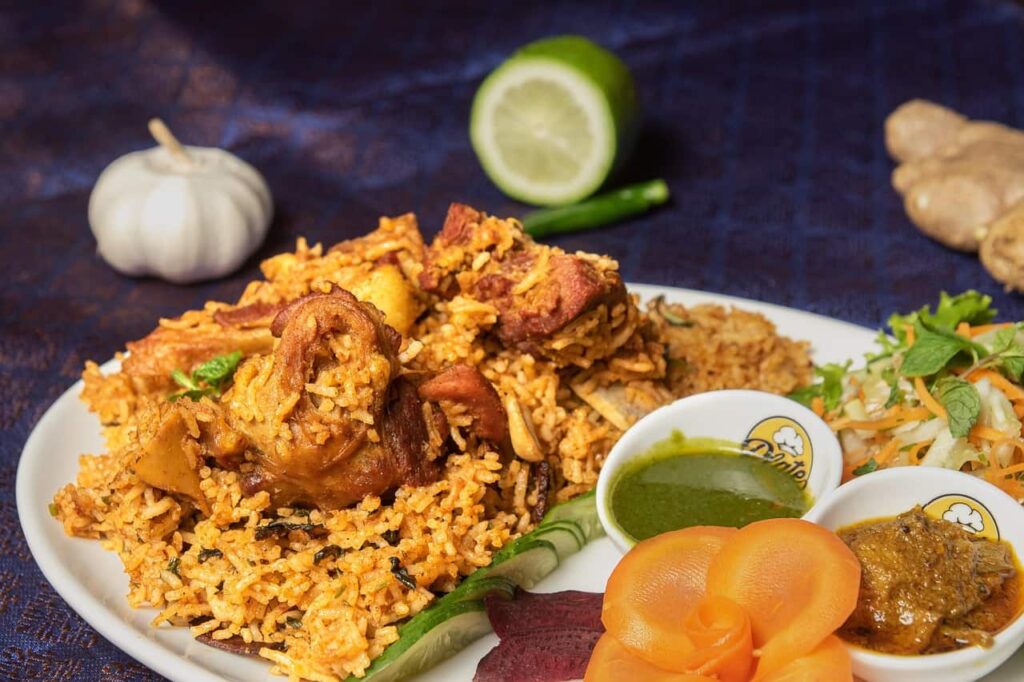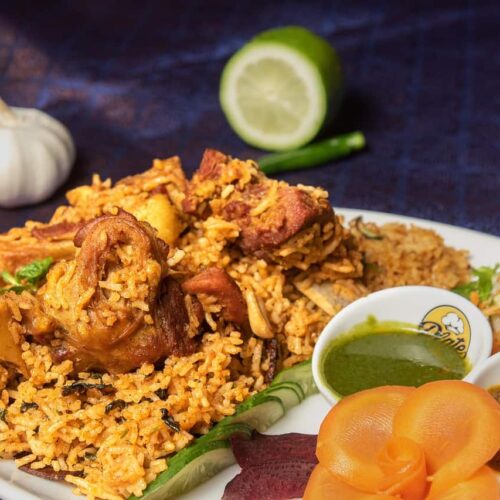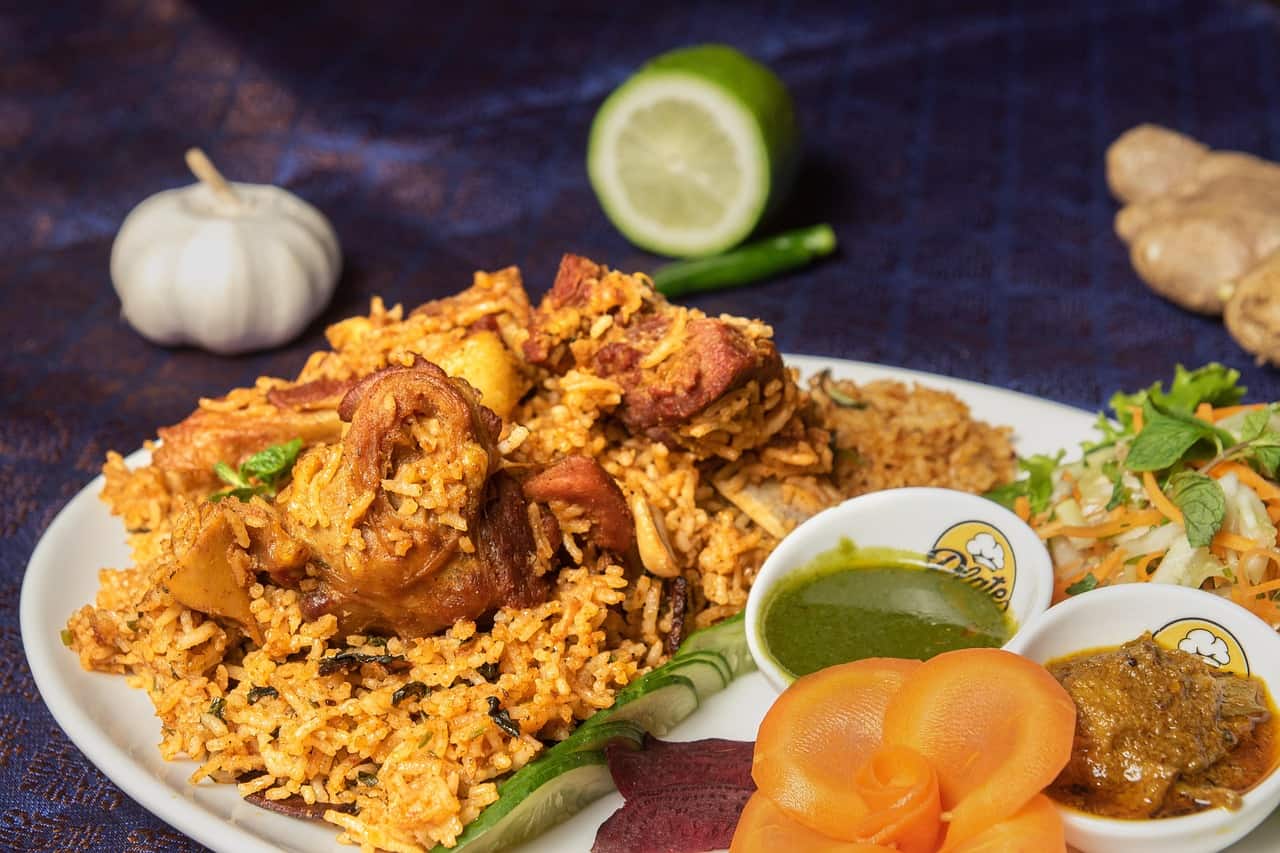Biryani is a flavorful and aromatic mixed rice dish made with basmati rice, spices, and either meat (such as chicken, mutton, beef, or fish) or vegetables.

Ratings 05

What Is The Biryani
Biryani is a flavorful and aromatic mixed rice dish made with basmati rice, spices, and either meat (such as chicken, mutton, beef, or fish) or vegetables. It is a celebrated dish in South Asian cuisine, especially in India, Pakistan, Bangladesh, and Sri Lanka.
01. Key Features Of Biryani
- Layered Dish: Traditionally, biryani is prepared by layering marinated meat and partially cooked rice, then slow-cooked together (a method called dum).
- Rich in Spices: Includes a blend of spices such as cumin, cardamom, cinnamon, cloves, and biryani masala.
- Aromatic: For a wealthy fragrance and smell, this is commonly infused with saffron, fried onions, mint, coriander, and rose or kewra water.
- Serve it with salad, boiled eggs, gravy, or raita (yogurt dip).
02. Popular Types Of Biryani
- Hyderabadi Biryani – Spicy and layered, often cooked using the dum method.
- Lucknowi (Awadhi) Biryani: Sluggish with stock, it’s milder and more fragrant.
- Sindhi Biryani – Tangy and spicy with potatoes.
- Sri Lankan biryani, which is infused with geographic spices, is typically served with boiled eggs and sambol.
- Vegetable Biryani – A meatless version with assorted vegetables and the same rich flavors.
03. Origin:
Mughal emperors have been assumed to have brought biryani to the Indian subcontinent, which is believed to have Persian origins. It altered throughout Southeast Asia as a consequence of regional adaptations.
Health Benefits Of Biryani
While biryani is often considered a rich and indulgent dish, it can offer several health benefits when made with quality ingredients and moderate oil. Here are the key benefits:
01. Good Source Of Protein
- Meat-based biryani (chicken, mutton, beef, or egg) provides high-quality protein, essential for muscle repair, immunity, and overall strength.
- Vegetable biryani contains plant-based proteins from legumes or paneer.
02. Energy Booster
- Basmati rice offers complex carbohydrates that start giving you lengthy energy and help you feel fuller.
03. Spices With Medicinal Properties
Common biryani spices such as:
- Turmeric – anti-inflammatory, immune-boosting.
- Cloves and cinnamon help relieve digestion and maintain blood sugar levels.
- Cardamom and bay leaves – help in detoxification and improve gut health.
04. Rich In Micronutrients
- Ingredients like onions, garlic, tomatoes, coriander, and mint provide vitamins A, C, and K, as well as antioxidants.
05. Supports Brain And Mood
- Biryani includes spices and herbs that stimulate the brain and improve mood.
- Some versions include nuts or saffron, which are rich in antioxidants and may support brain function.
06. Complete Meal In One
- Biryani is a one-pot meal combining protein, carbs, and fats—making it a balanced dish when served with sides like salad or yogurt.
07. Tips For A Healthier Biryani
- Use brown basmati rice for more fiber.
- Then choose lean meats, such as chicken breast, or prefer tofu or vegetable biryani.
- Reduce oil and ghee; opt for baking or pressure cooking.
- Add more vegetables for fiber and nutrients.
Tips For Making Biryani
Here are some essential and practical tips for making delicious Biryani at home:
01. Choose The Right Rice
- Again, for the texture and fragrance of long-grain basmati rice, use it.
- Soak the rice for 20–30 minutes before cooking to help it cook evenly and fluff up.
02. Marinate The Meat Well
- Marinate chicken/mutton for at least 1–2 hours, or overnight if possible.
- Use yogurt, lemon juice, and spices to tenderize and flavor the meat deeply.
03. Fry Onions Until Golden Brown (Birista)
- Caramelized fried onions are key to authentic biryani flavor.
- Fry slowly on medium heat to avoid burning and enhance sweetness.
04. Use Whole And Ground Spices
- Whole spices (cardamom, cinnamon, cloves) add aroma.
- Biryani masala or garam masala enhances the depth of flavor—don’t overdo it.
05. Cook Rice Only 70–80%
- Parboil rice so it finishes cooking during the final steam (dum).
- Add some salt to this same boiling water to team rice.
06. Add Fresh Herbs And Aromatics
- Use chopped mint and coriander leaves for freshness.
- Saffron milk, rose water, or kewra water adds royal fragrance.
07. Layer Properly
- Alternate layers of rice and meat masala.
- Top with fried onions, saffron milk, and a sprinkle of herbs.
08. Dum Cook On Low Flame
- Seal the pot with dough or a tight-fitting lid.
- Cook on very low heat for 20–30 minutes, placing a tawa underneath to prevent burning.
09. Control The Oil/Ghee
- Use just enough oil or ghee to coat the meat and rice; too much makes it greasy.
10. Rest Before Serving
- Let the biryani rest for 10 minutes after dum cooking.
- This allows flavors to blend and steam to settle.
FAQ Biryani
Here’s a helpful FAQ (Frequently Asked Questions) section for Biryani:
01. What Is The Difference Between Biryani And Pulao?
Biryani is layered and cooked using the dum method (steam cooking), with partially cooked rice and marinated meat/vegetables.
Pulao is typically cooked by sautéing all ingredients together and simmering them in one pot.
02. Can Regular Rice Be Used In Place Of Basmati?
Even though basmati rice is preferred for its long grains and aroma, you can still do it. Normal rice could perhaps clump together or become mushy.
03. Is Biryani Always Spicy?
No. You can adjust the spice level according to your taste. Mild versions are just as flavorful with aromatic spices and herbs.
04. How Do I Prevent Biryani From Turning Soggy?
- Don’t overcook the rice.
- Avoid excess water or too much gravy.
- Use a thick-bottomed pan and proper dum technique.
05. What kind Of Meat Is Best For Biryani?
Popular choices include:
- Chicken – cooks quickly and absorbs flavor.
- Mutton – rich and traditional (requires longer cooking).
- Regional variations also use shrimp, fish, or beef.
06. How Can I Add Flavor To Vegetarian Biryani?
Make use of hearty vegetables such as paneer, peas, beans, carrots, and potatoes. Add saffron, fried onions, and whole spices for aroma and depth.
07. Can I Make Biryani Without Yogurt?
Yes.
Yogurt helps tenderize meat and adds tang, but you can substitute with tomato puree, coconut milk, or lemon juice.
08. How Long Should I Cook Biryani On Dum?
Usually 20–30 minutes on low heat. For mutton, you might need extra time or pre-cook the meat before layering.
09. Can Biryani Be Reheated?
Yes.
Reheat using a steamer, microwave, or stovetop with a sprinkle of water and a lid to keep it moist.
10. What Are The Best Side Dishes For Biryani?
- Raita (yogurt with cucumber/onions)
- Salad
- Boiled eggs
- Pickles
- Papad or gravy curry (like salan or korma)

Biryani
Ingredients
For Rice
- 2 cups Basmati rice
- 4 cups water
- 1–2 bay leaves
- 4–5 cloves
- 2–3 green cardamoms
- 1 black cardamom (optional)
- 1 small cinnamon stick
- Salt to taste
For Chicken Or Mutton (You Can Substitute With Vegetables For Veg Biryani)
- 500g chicken (or mutton), cut into pieces
- 1 cup yogurt
- 1 tablespoon ginger-garlic paste
- 2 teaspoons red chili powder
- 1 teaspoon turmeric powder
- 1 teaspoon garam masala
- Salt to taste
- Juice of half a lemon
For Biryani Masala Base
- 2 large onions, thinly sliced
- 2 medium tomatoes, chopped
- 1/4 cup chopped mint leaves
- 1/4 cup chopped coriander leaves
- 2–3 green chilies (slit)
- 2–3 tablespoons cooking oil or ghee
- 2 tablespoons Biryani masala (store-bought or homemade)
Optional Toppings
- Saffron soaked in 2 tablespoons warm milk
- Fried onions (for garnish)
- A few drops of rose water or kewra water
Instructions
Step 1: Marinate The Meat
- Mix chicken/mutton with yogurt, ginger-garlic paste, chili powder, turmeric, lemon juice, garam masala, and salt.
- Let it marinate for at least 30 minutes (preferably 2–4 hours).
Step 2: Prepare The Rice
- Rinse basmati rice and soak it for 30 minutes.
- Boil water in a large pot, add whole spices (bay leaf, cloves, cardamoms, cinnamon), and salt.
- Add soaked rice and cook until 70–80% done. Drain and set aside.
Step 3: Cook The Masala Base
- Heat oil or ghee in a pan. Fry sliced onions until golden brown.
- Add chopped tomatoes, green chilies, mint, and coriander leaves.
- Add marinated meat and cook until meat is tender and the masala thickens. (For mutton, you might need to add a little water and pressure cook.)
Step 4: Layer The Biryani
- In a heavy-bottomed pot, add a layer of meat masala.
- Add a layer of partially cooked rice on top.
- Repeat layers if needed.
- Drizzle saffron milk, fried onions, and rose/kewra water on top.
Step 5: Dum Cooking (Steaming)
- Seal the pot with a tight lid or dough.
- Cook on low heat for 20–25 minutes (place a tawa underneath the pot if needed to prevent burning).
Step 6: Serve
- Gently fluff up the layers and serve hot with raita, salad, or boiled eggs.
-
Biryani
Biryani is a flavorful and aromatic mixed rice dish made with basmati rice, spices, and either meat (such as chicken, mutton, beef, or fish) or vegetables. Ratings 05 What Is The Biryani Biryani is a flavorful and aromatic mixed rice dish made with basmati rice, spices, and either meat (such as chicken, mutton, beef, or…


Leave a Comment